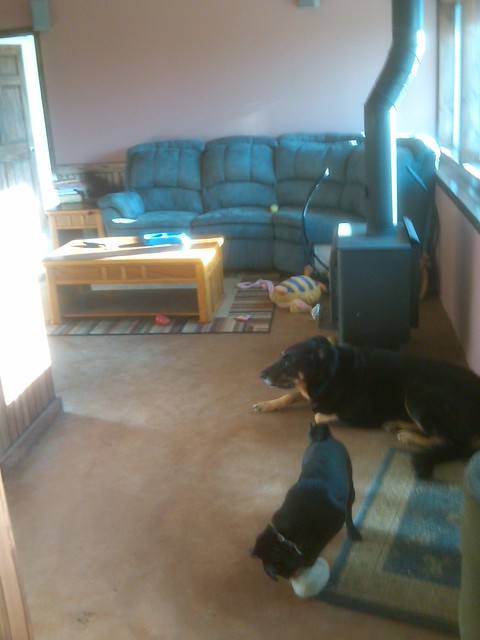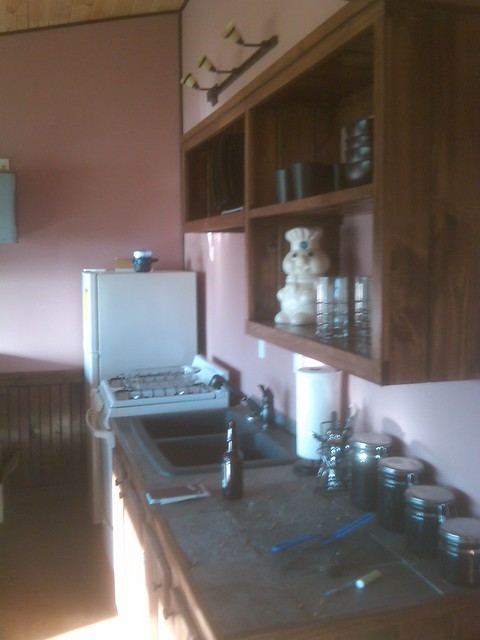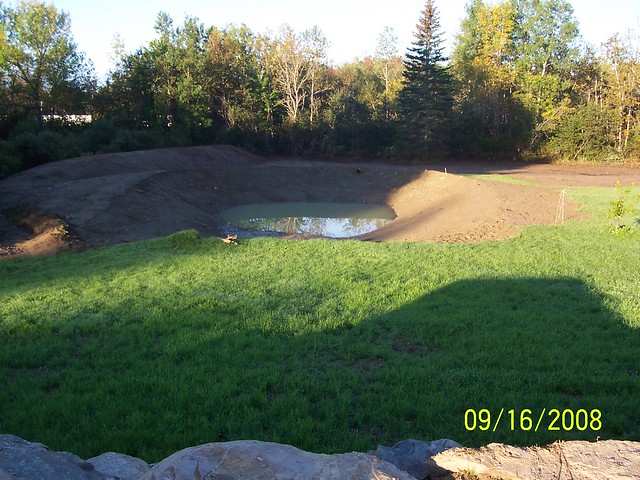J,moe and roli had asked me how I feel about our house after living in here for awhile, what would I change, cost to build, etc
First things first the cost break down
tile and sinks ect 1803.21
appliances 2595.85
hot water tnk 1292.94
material 8496.35
equip rental 392.04
electrical 2323.93 includes 750 for pole
plumbing 2101.24
cement 5105.24 includes 725 for pump truck
labor 8933.26
windows 1386.75
metal roof 1899.89
gas rough in 520.8
ground work 4500
misc 7739.46 This would be paint, pine we kept going and picking up, ect, things that don't seem alot when you get it but it adds up to alot, wish I could break it down more, but I didn't save receipts
total 49090.96
now this doesn't include the 2000 we paid for the block last year, or the 8000 for groundwork to build up the pad, water and sewer hook up, so total would be 59090.96
significant savings would be had in the labor, plumbing and groundwork
we took a flat field and built it up to berm around the house, if you could find a site that has a hill and dig into it, you would save about 2/3rds of that price, hell you could even rent a excavator and do it yourself
labor, if I wanted to build it over a year instead of 3 or 4 months, that line would have been zero
Plus, my wife wanted the 300 dollar basin sink instead of a cheap 50 dollar unit ect.
What would I change?
The roofline, when we originally thought of it, the idea was to open the top windows and allow natural convection suck the warm air out of the house and bring in cool air through the front windows. The reality is with the washer/dryer, ect in the way to get up there to open and close the windows is a pain. Besides the fact it takes a 12 foot step ladder to reach them which we keep along side my dads shed, if a rainstorm comes in you need to be able to get up there quick to close the window or else rain will get driven in through the opening. I could install a awning over the windows and keep that from happening I suppose.
The storage we built in the bedrooms up in the roof is the same issue, getting up there involves going outside and getting a step ladder and crawling up there.
I would have just gone with a traditional roofline and installed solar tubes for lighting in the back rooms. Plus, there would be cost savings in this with material and labor. Hand framing that roofline was very labor intensive versus just having trusses delivered and nailed in place in a afternoon.
Another issue we have with the roofline is that the front flatter part of the roof doesn't shed snow, we have to get up several times a year and rake off the snow. Wouldn't be a issue down south but here where we get 100 plus inches of snow a year, it is a issue.
I would have pinned the walls to the footing instead of depending on the slab to keep the wall from kicking in.
I would have replaced the sliding windows in the living room with sliding glass doors which would have allowed in more light and made the patio more of a outdoor living space. Believe it or not it would also have helped with heating in the winter. The way the windows sit and where the sun is on the horizon during the winter the daytime sunlight hit's the backwall and we don't get to utilize solar gain that much on the thermal mass of the floor.
I would have installed the earth tubes which was in our original plans, I wanted to tie them into the footing drain around the house but when we were backfilling the house with all activity it totally slipped my mind.
Here is the basic concept, through convection hot air escaping from the house draws in cool air through the pipes that have been buried in the soil, The earth maintains a constant temperature below 4 feet of 52 degrees, so you could utilize all natural air conditioning, it also works in the reverse during winter time. Instead of your woodstove sucking in 10 degree air from the outside, the earthtubes prearm the air to 52 degrees.

I would have made the island bar smaller, it takes up a large amount of floor space.
I would have moved the bedroom door on the left up front to match the door entry in the other room

I would have moved the bathroom doorway over to where the fridge is

this would have given us more options as far as laying out furniture, as it is all we can do is put a couch against the wall due to the doorways in the corner and the woodstove
I would have made the shower more normal size, the large one is nice, but it takes up a lot of floor space, with a small home like this, space and storage is a premium.
The idea after our daughter moves out we are going to open up the wall behind the couch and actually have a living room. Plus it guarantees she can't move back in. Bonus!
If I had the money I would have spray foamed the whole house instead of using rolled insulation but the quote we got was almost 5000 dollars, I couldn't justify it being almost 10 percent of our build cost.
Performance energy wise is outstanding.
We have a on demand propane h2o heater, propane dryer and propane stove and we use about 8 gallons of propane a month.
Our electricity bill runs us about 90 dollars a month which to people might sound expensive but we pay high electrical costs here in Maine, our "normal" home before we moved in was averaging 300 dollars a month. I would safely say that when our daughter moves out our electrical bill should drop a lot.
Firewood we use about 1/2 to 3/4 cord of wood a season. Rinkus dropped us off 2 cords 2 to 3 years ago and we burned through well over a cord of it this year due to it being so dry after sitting there so long. Lesson learned don't stockpile so much firewood. It feels good to know we can basically pick dead fall off our 9 acres and heat our home for the rest of our lives.
That's all I can think of right now, anyone have any other specific questions?
8 Mar ’12
 Offline
Offlinek, i think you posted a company doing prefab synthetic dome construction that is made to be buried (earth sheltered). is this something you would now consider for cost savings?
have you ever measured the air quality in the home (i.e. co2 detectors, humidity)? does it vary seasonally?
And the monkey presses the button.
No, if I had to do it over, I would probably still go with this method. If I wanted to speed up the process I could have had someone pour the walls and floor. The quotes I got for that ranged from 14,000 to 20,000. I did it myself for just over 7000.
We have never measured air quality, but we did tun a dehumidifier the first year while the cement was curing. We have looked under area rugs and such and have never seen any wicking issues.
Actually that brings up a good point though, with 3 dogs, 2 cats and cement floors, animal hair and dust in general is a issue. We had been talking about putting carpet down to help control that and be able to vacume instead of sweeping which just spreads the dust everywhere. My wife is constantly dusting. In hindsight it's good thing we didn't with the sewage back up, but now that has been addressed, we still might look into putting carpet down. My concern is they are going to have to glue it down to the cement, but I have not talked to the carpet store at all yet to see what our options are
4 Mar ’12
 Offline
OfflineI have a few questions. I'm seriously considering this option for my new home and I'm glad to see this thread. ![]()
Did you just dig a hole for your pond? no liner?
does it fill up from the bottom or is it filled from rain water?
No insulation for your water storage tanks? Do you empty them before winter sets in?
How did you secure the foam insulation to the outside of the brick wall? fasteners, construction adhesive, black magic?
Do you like you metal roof and are there any special tricks to installing one? any special tools?
I noticed your water was brought to an inside wall. was this to prevent freezing? (seeing as an outside line would be in the elements)
^^ keep in mind I've never seen snow ^^ so it's a legit question.
Ever consider going all the way under the ground?
like the pic in the passive heat storage (above)
I have a few questions. I'm seriously considering this option for my new home and I'm glad to see this thread. ![]()
Did you just dig a hole for your pond? no liner?
does it fill up from the bottom or is it filled from rain water?
No insulation for your water storage tanks? Do you empty them before winter sets in?
How did you secure the foam insulation to the outside of the brick wall? fasteners, construction adhesive, black magic?
Do you like you metal roof and are there any special tricks to installing one? any special tools?
I noticed your water was brought to an inside wall. was this to prevent freezing? (seeing as an outside line would be in the elements)
^^ keep in mind I've never seen snow ^^ so it's a legit question.
Ever consider going all the way under the ground?
like the pic in the passive heat storage (above)
We have very heavy clay soil so we just dug a hole and compacted it, when we were digging we hit a small spring that slowly started filling it, this was a couple weeks after we finished it

I got tired of waiting so I had 2 tanker trucks of water brought in and topped it off, now rain and the spring keep it full
we drain the water tanks each fall
the insulation extends up to the wood framing so we screwed down the top to the wood and when we backfilled it took care of the bottom
the metal roof just gets screwed down, it's pretty simple really. We have a local menonite family who sells it, we just gave them the length we needed and they cut it so it would go up in one sheet, the only trick we did was when all the sheets were stacked on each other, we pre-drilled the holes for the screws through the whole stack. That way when we screwed them down all the screws line up, not really required but it looks good
yep, we have to bring inside inside under the frost line or it will freeze. We actuaally had to put rigid foam insulation over it and the sewer pipe in the last 20 feet to the house because we were close to the frost line. People do have issues with their sewer pipes up here freezing some times. It sucks having to thaw them out, you basically have to stick a hose running hot water down it
we had considered going underground totally, but we decided to go with a more traditional roofline for several reasons, one is being able to sell it. I plan on dying in this house, but plans change sometimes as we get older, I'm not sure what the future holds. Sometimes if you get to funky with designs it will turn off potential buyers and mortgage companies. Even as it is we might have a issue selling it due to the fact we do not have a thermostatically controlled heat source, mortgage companies and insurance companies frown on this
Most Users Ever Online: 698
Currently Online:
123 Guest(s)
Currently Browsing this Page:
1 Guest(s)
Top Posters:
easytapper: 2149
DangerDuke: 2030
groinkick: 1667
PorkChopsMmm: 1515
Gravel Road: 1455
Newest Members:
Forum Stats:
Groups: 1
Forums: 12
Topics: 11482
Posts: 58640
Member Stats:
Guest Posters: 2
Members: 19842
Moderators: 0
Admins: 1
Administrators: K

 Log In
Log In Home
Home








